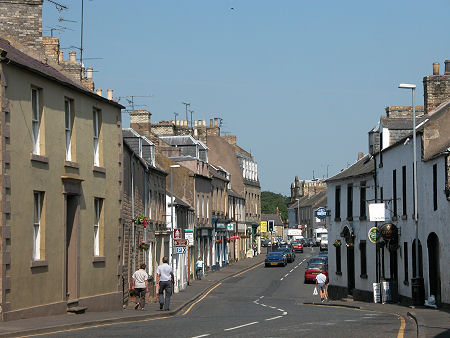 Coldstream, from where Monck Began his March South on 1 January 1660 |
George Monck, 1st Duke of Albemarle, lived from 6 December 1608 to 3 January 1670. Also known as the Earl of Torrington, and Baron Monck of Potheridge, Beauchamp And Teyes, Monck was an English soldier who served as Cromwell's military governor in Scotland and who later brought about the restoration of Charles II. The wider picture in Scotland at the time is set out in our Historical Timeline.
George Monck was born near Torrington in Devon, the second son of Sir Thomas Monck. He began his military career at the age of 16, joining the English expedition against Cadiz in 1625. Back in England, Monck stabbed the Under-Sheriff for Devon after he had arrested Monck's father for debt. To escape prosecution he returned to the continent, taking part in English attacks on La Rochelle in 1627 and 1628. In 1629 he volunteered for the Dutch Army under the Prince of Orange fighting against the Spanish in the 30 Years' War. He spent 9 years in Dutch service before returning to England to take up a position in King Charles' army in the Bishops' Wars against Scotland as lieutenant-colonel in the Earl of Newport's regiment. He distinguished himself at the Battle of Newburn by saving the English Artillery from a Scottish attack.
In the Irish Rebellion of 1641 Monck served as colonel of Lord Leicester's regiment, though his subsequent appointment as Governor of Dublin was overturned by Charles I. Charles did, however, give Monck command of the Irish Army brought over to support the Royalist Cause in the English Civil War. In January 1644 Monck was captured by Roundheads at the Battle of Nantwich, and spent two years as a prisoner: time he put to good use writing his book Observations on Military and Political Affairs.
On his release, Monck was given a command in the Parliamentary Army and sent unsuccessfully to quell a rebellion in Ireland. In 1651 he took part in Cromwell's conquest of Scotland, commanding Monck's Regiment of Foot. This had been formed on 23 August 1650 from elements of existing regiments which had been unhappy to be led by him because of his Royalist background. Monck and his regiment both distinguished themselves at the Battle of Dunbar on 3 September 1650.
Monck was given command of the Parliamentary army in Scotland to complete the conquest of the country after Cromwell had pursued Charles II's main army to England. Monck was in charge of the Parliamentary troops that took Stirling Castle on 14 August after a 10 day siege, and captured Dundee on 1 September. He made an example of the latter city, standing by while his troops sacked it, killing up to 2000 of its 12,000 population and destroying the 60 ships in the city's harbour. In 1652, the last remains of organised Royalist resistance in Scotland was overcome, and Dunnottar Castle became he last stronghold to fall to Monck's troops, on 26 May 1652.
Under the Tender of Union then imposed on the Scots, they were given 30 seats in a united Parliament in London, and General Monck was appointed as the military governor of Scotland. During the Interregnum, Scotland was kept under the military occupation of an English Parliamentary army. To keep a tight grip in spite of a number of Royalist uprisings in Scotland, Monck placed strong garrisons across the country in key centres such as Inverness and Ayr. Resistance was only finally quelled after he began to ship prisoners as slaves to the West Indies.
In 1653 Monck took charge of the English Navy in the First Anglo-Dutch War, a war that was the beginning of the end of the supremacy at sea of the Dutch, and the start of the ascendancy of England as a naval power. In the course of the campaign he introduced many technical and tactical ideas (such as signal flags and the line of battle) that were to influence naval tactics for centuries to come. In April 1654 General Monck returned to Scotland to defeat the Royalist uprising under the command of Major-General John Middleton, who had arrived in Dornoch from Holland earlier in the year. The crucial Parliamentary victory took place on 19 July 1654, when Monck's forces surprised Middleton at Dalnaspidal near Loch Garry.
Oliver Cromwell died in 1658, and a number of competing factions struggled for power in England while Monck quietly watched developments from Edinburgh while keeping in touch with Charles II in Holland using the architect William Bruce as a go-between. On 24 November 1659, Monck was appointed the commander in chief of all Parliamentary forces in Britain. In December 1659 he gathered an army of 5,000 foot and 2,000 horse at Coldstream, right on the Sottish-English border. The troops included Monck's Regiment of Foot, which as a result later adopted the title of the Coldstream Guards and which survives as one of the world's oldest military formations. On 1 January 1660 Monck started his march south, arriving in London on 2 February. He kept his intentions entirely to himself, but having assumed effective control of London, he recommended to Parliament on 1 May that they should invite Charles II to resume power. When the king landed at Dover on 25 May he was met by Monck.
Charles II was duly grateful to the man who had masterminded the Restoration without blood being spilled, rewarding him with a vast pension of £7,000 per year and a one-eighth share of the Province of Carolina. Monck died on 3 January 1670 and was buried in Westminster Abbey.
